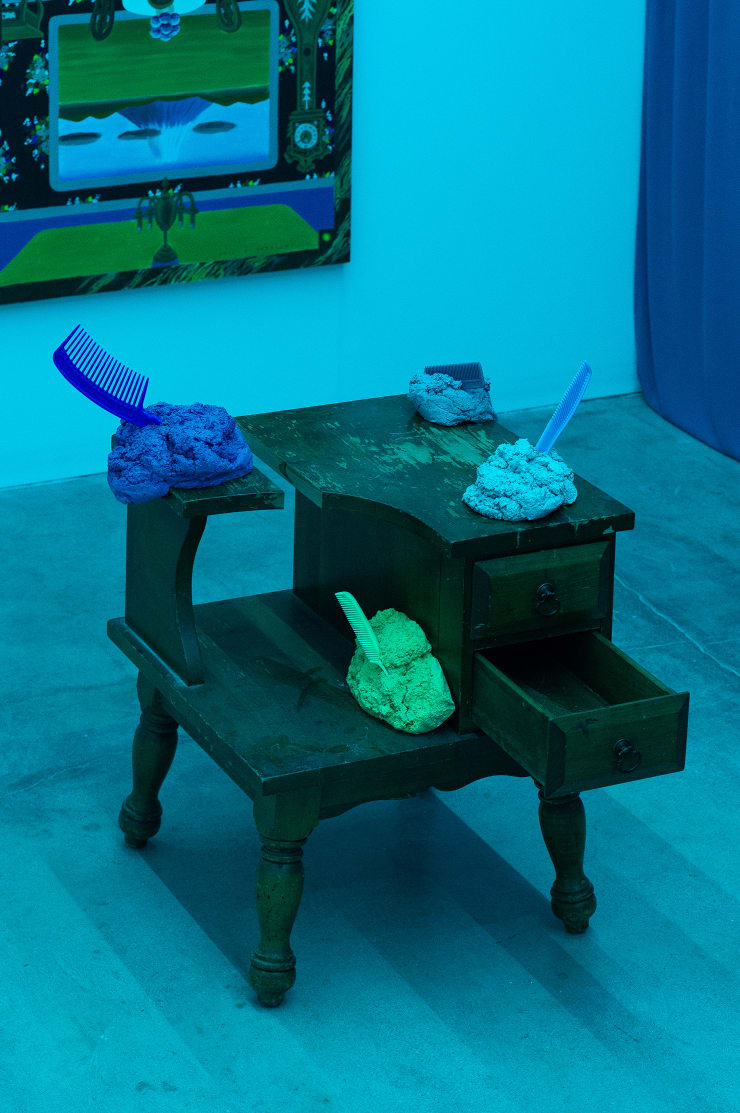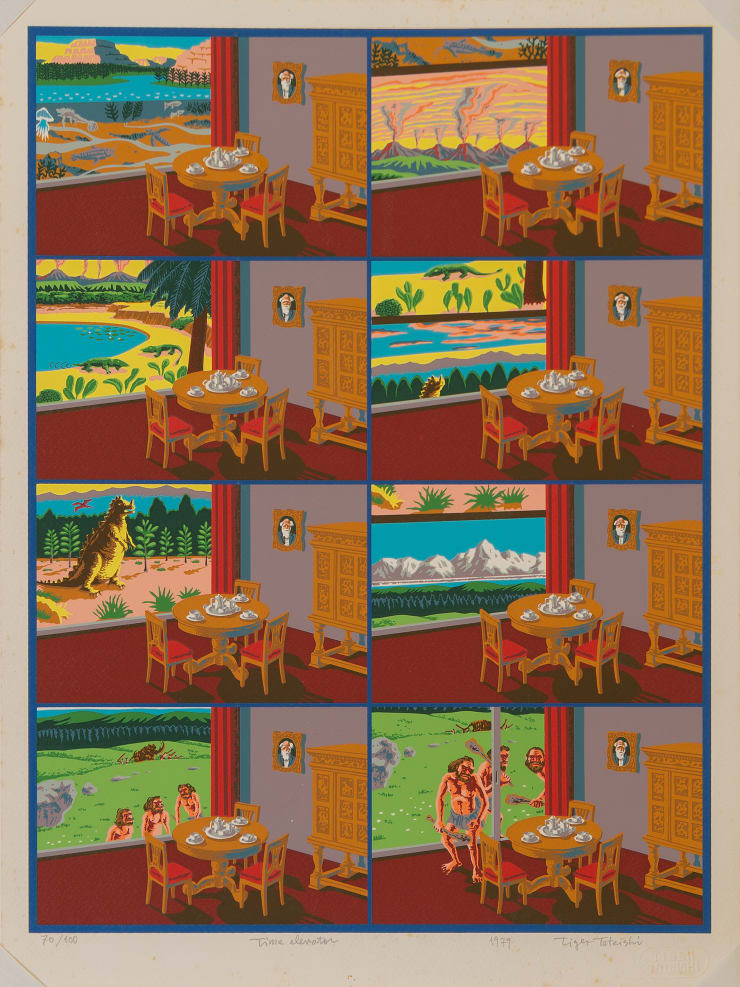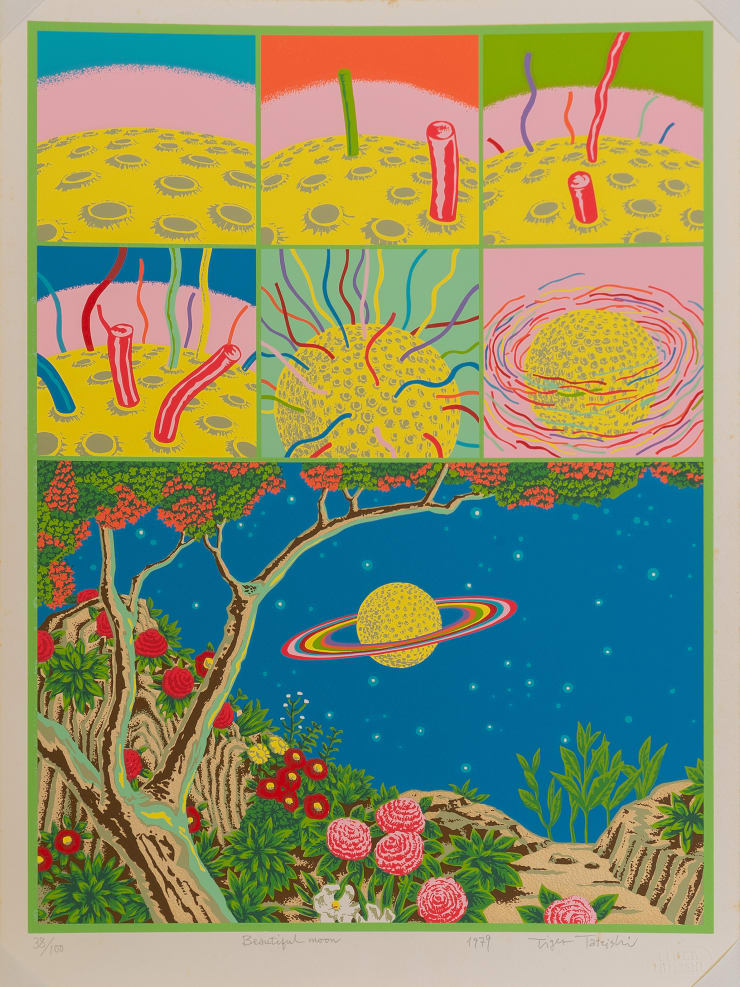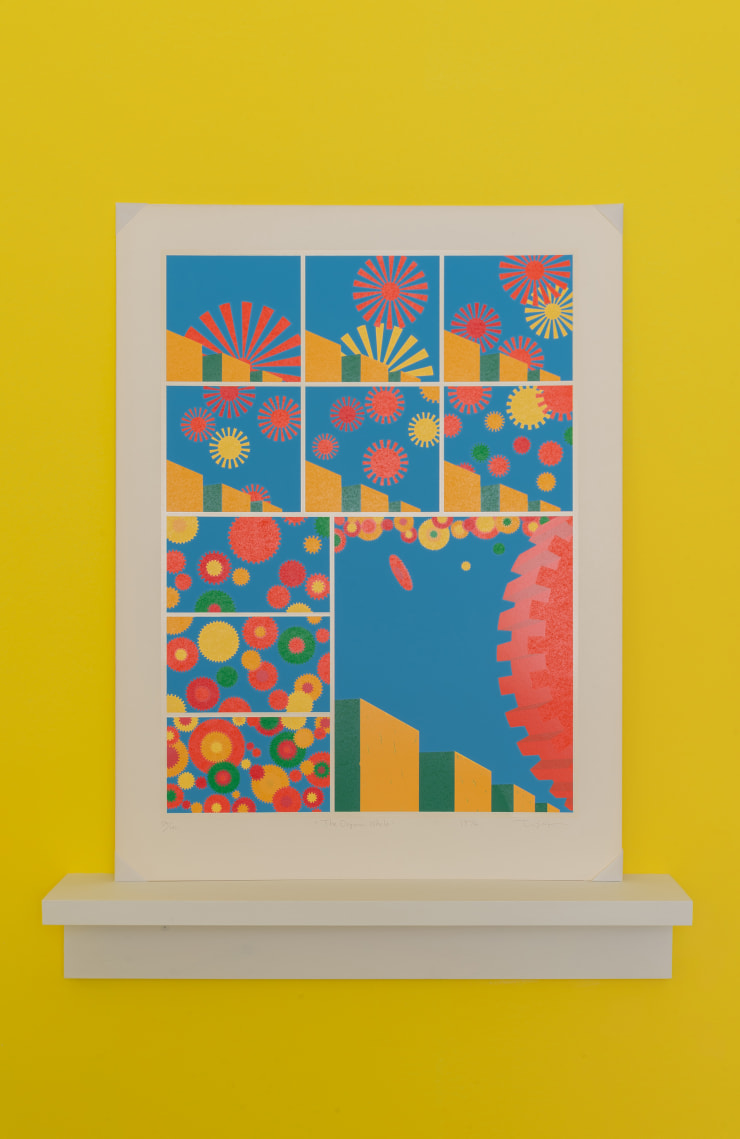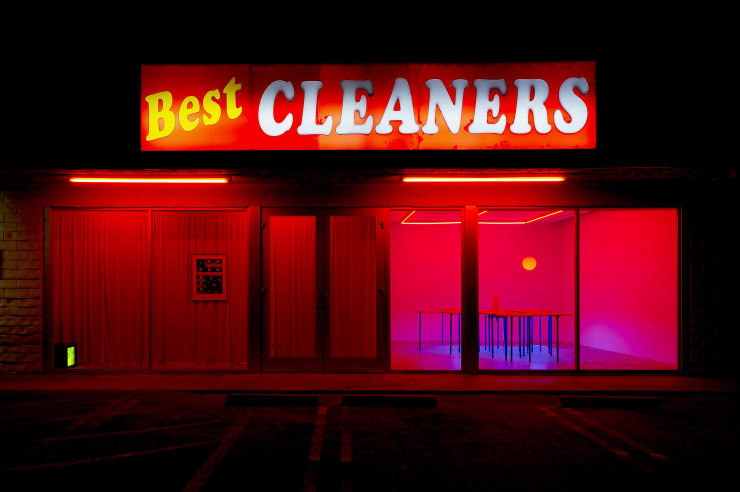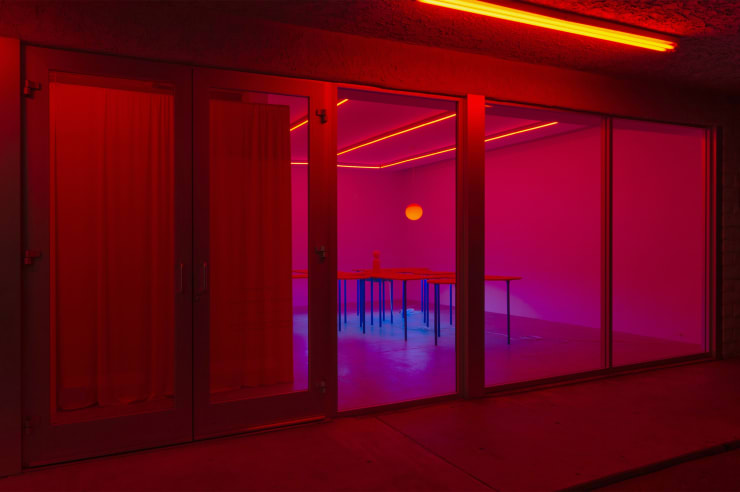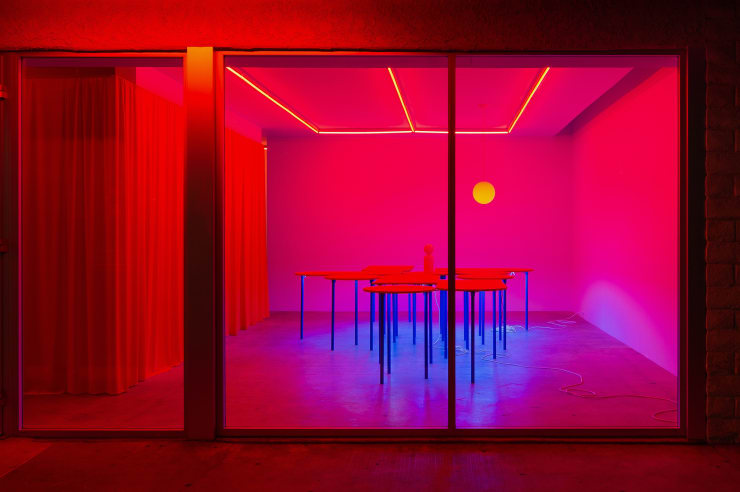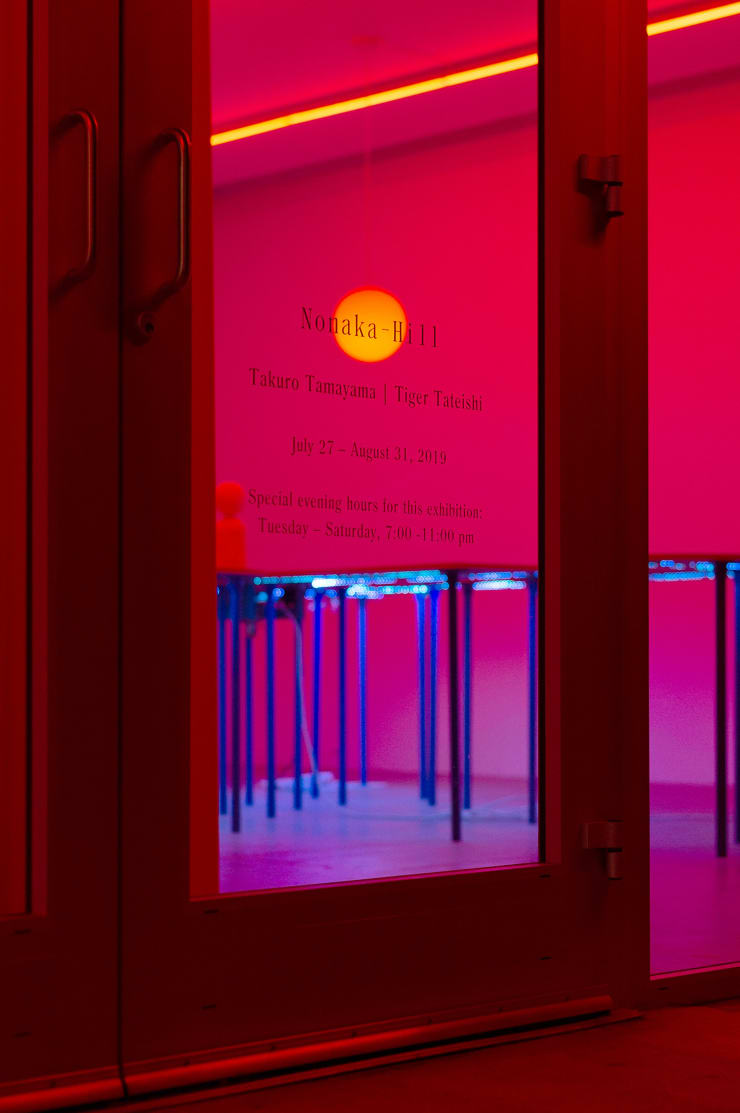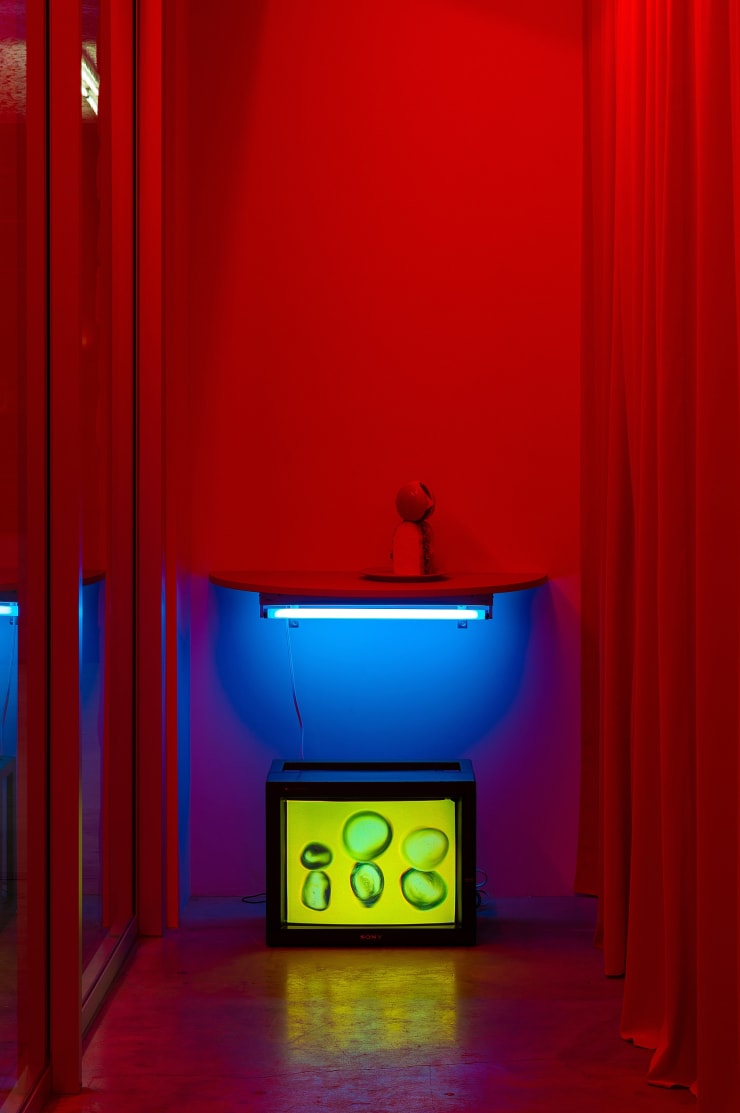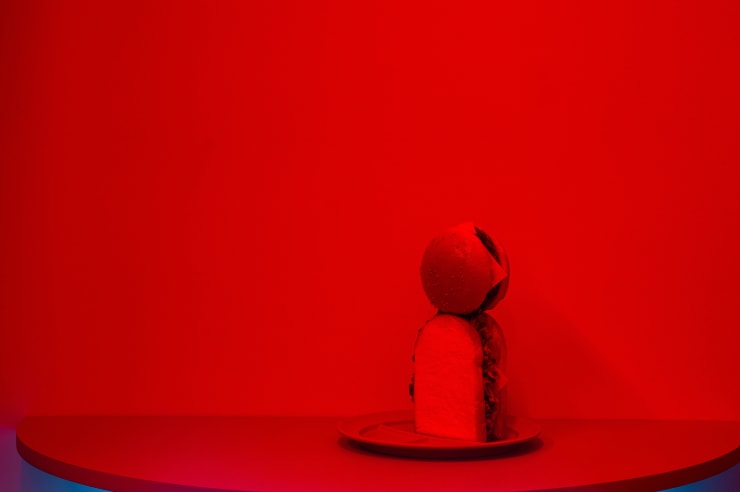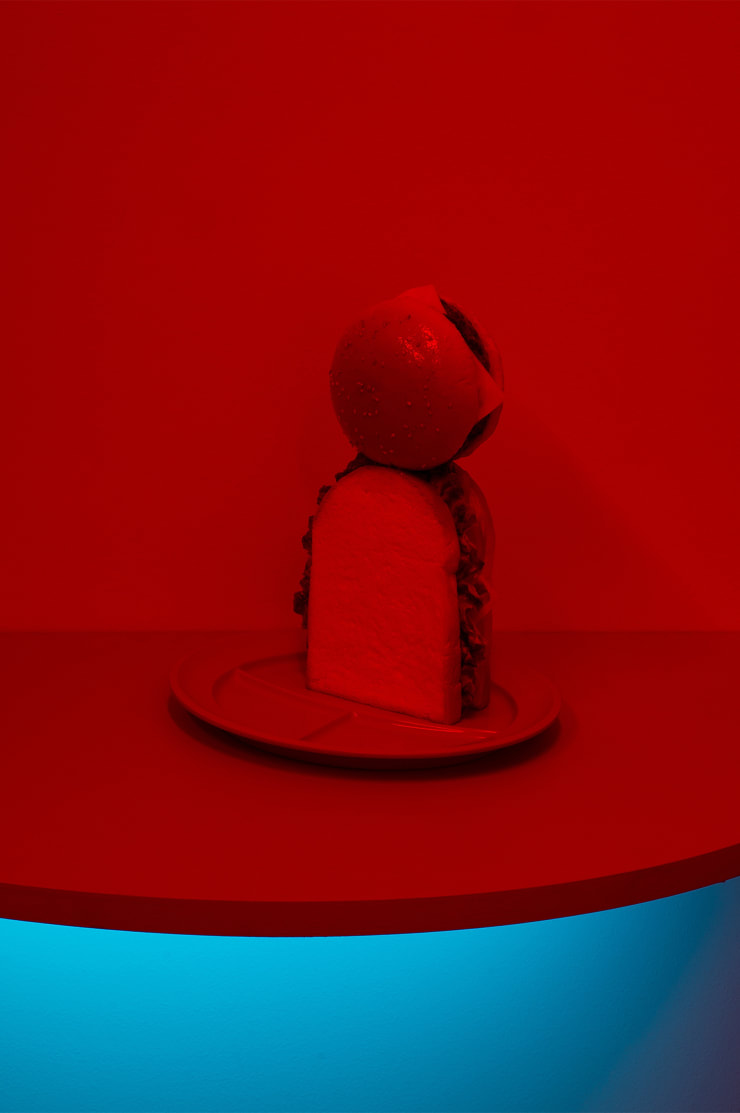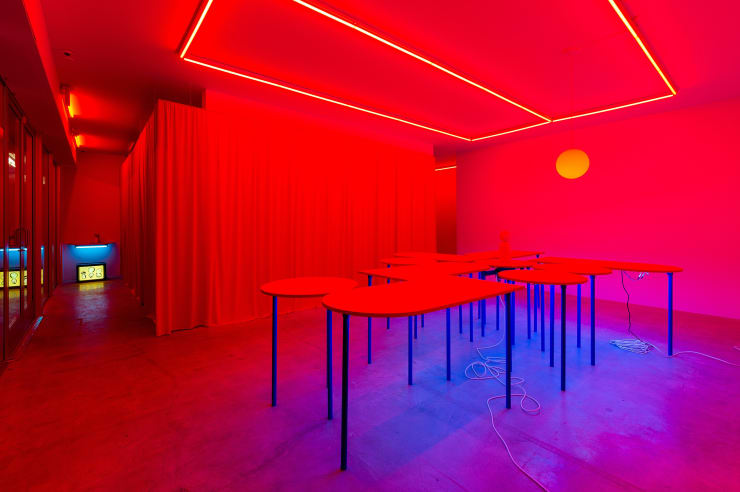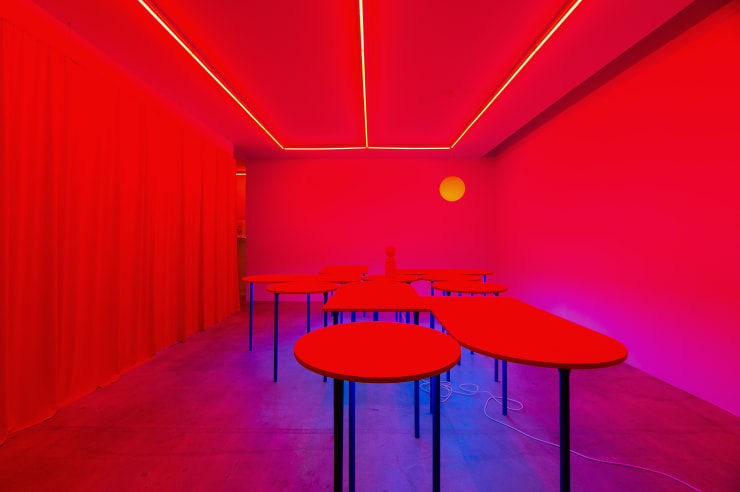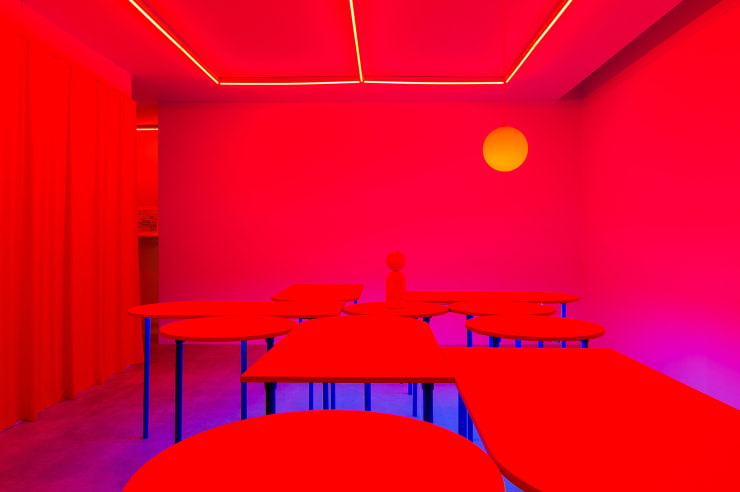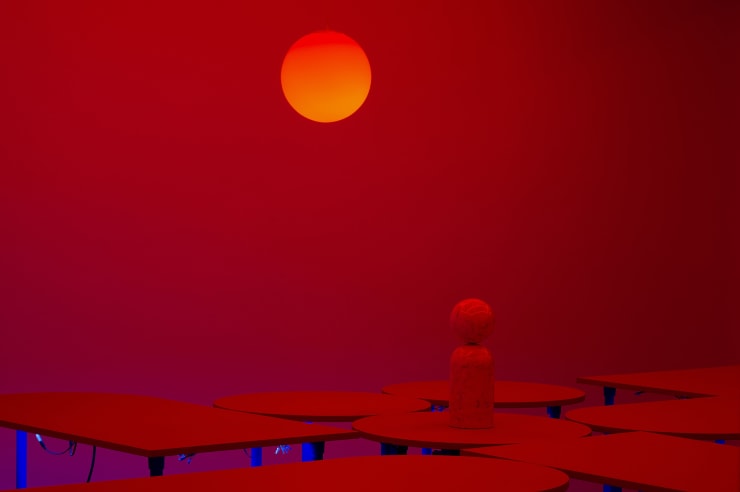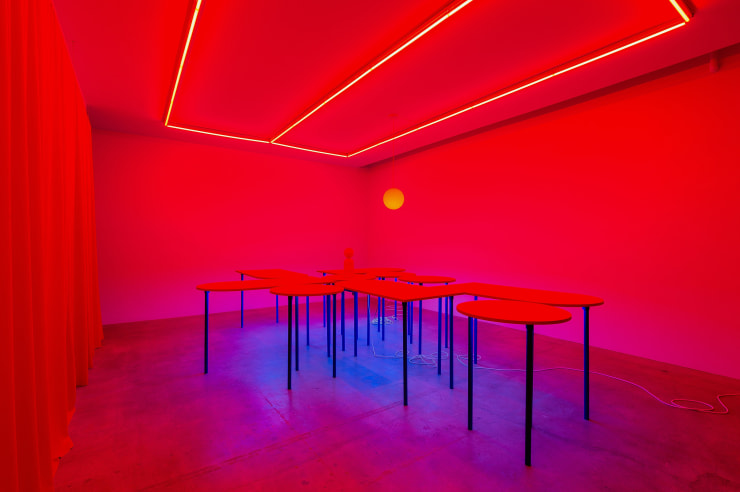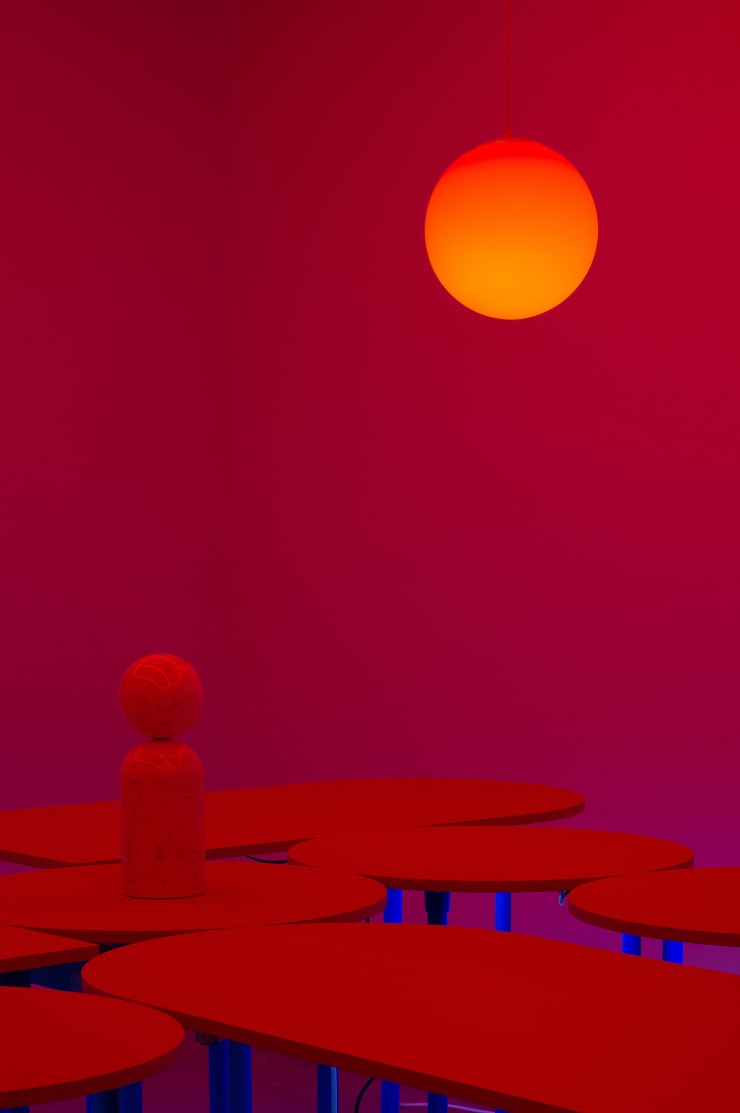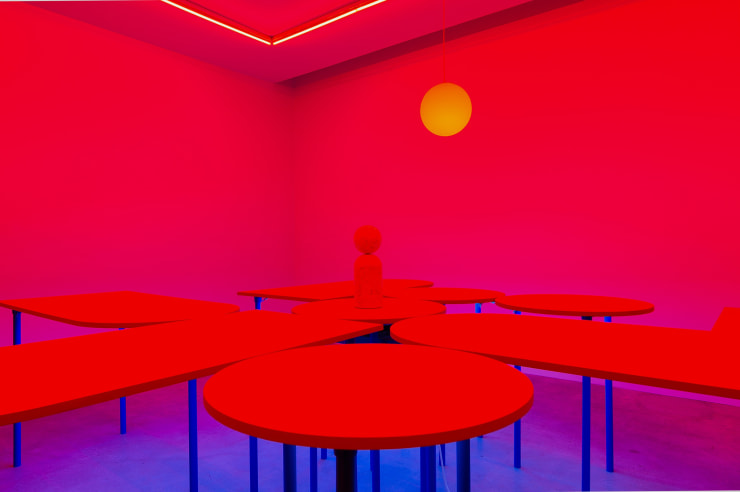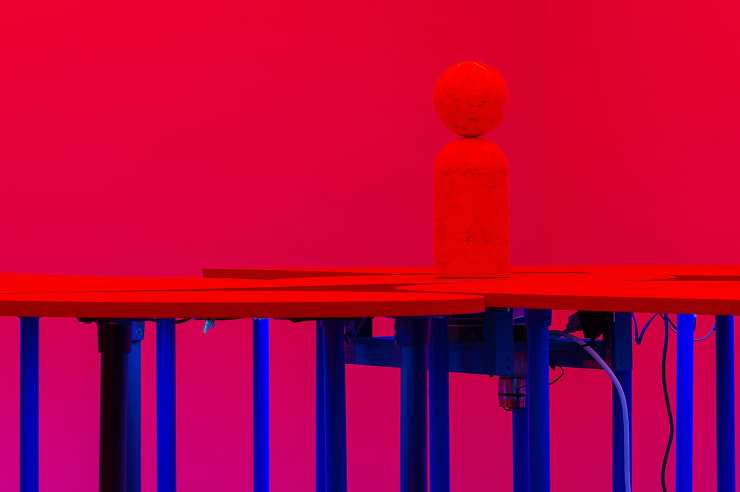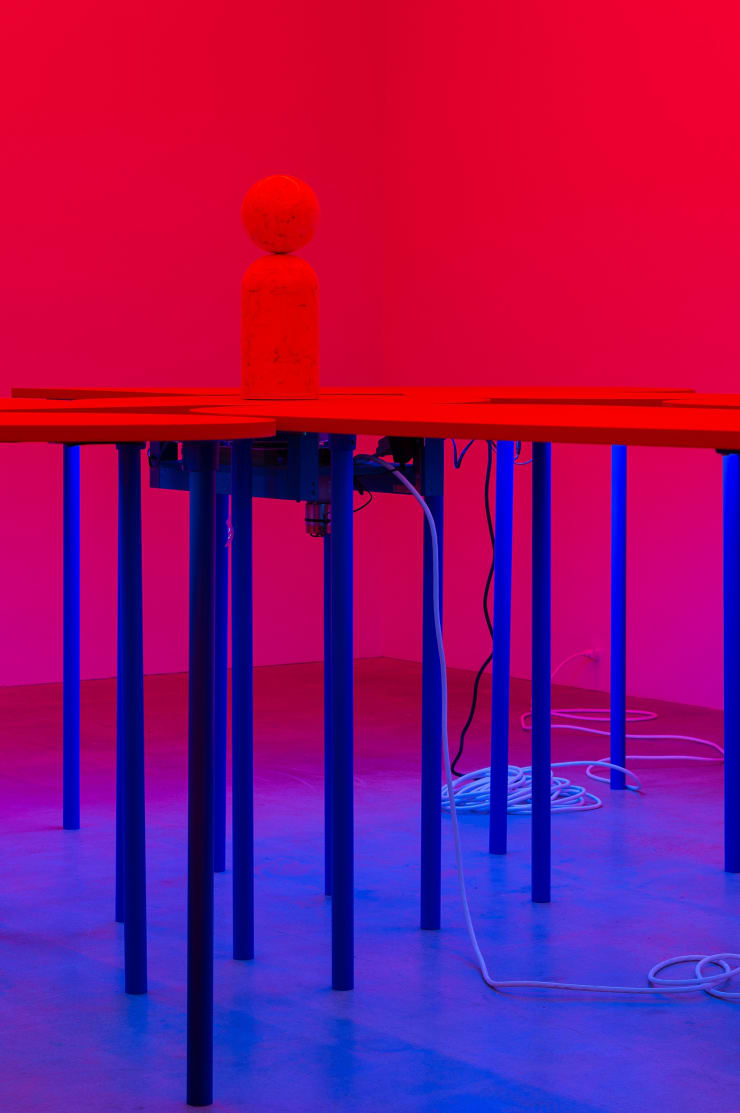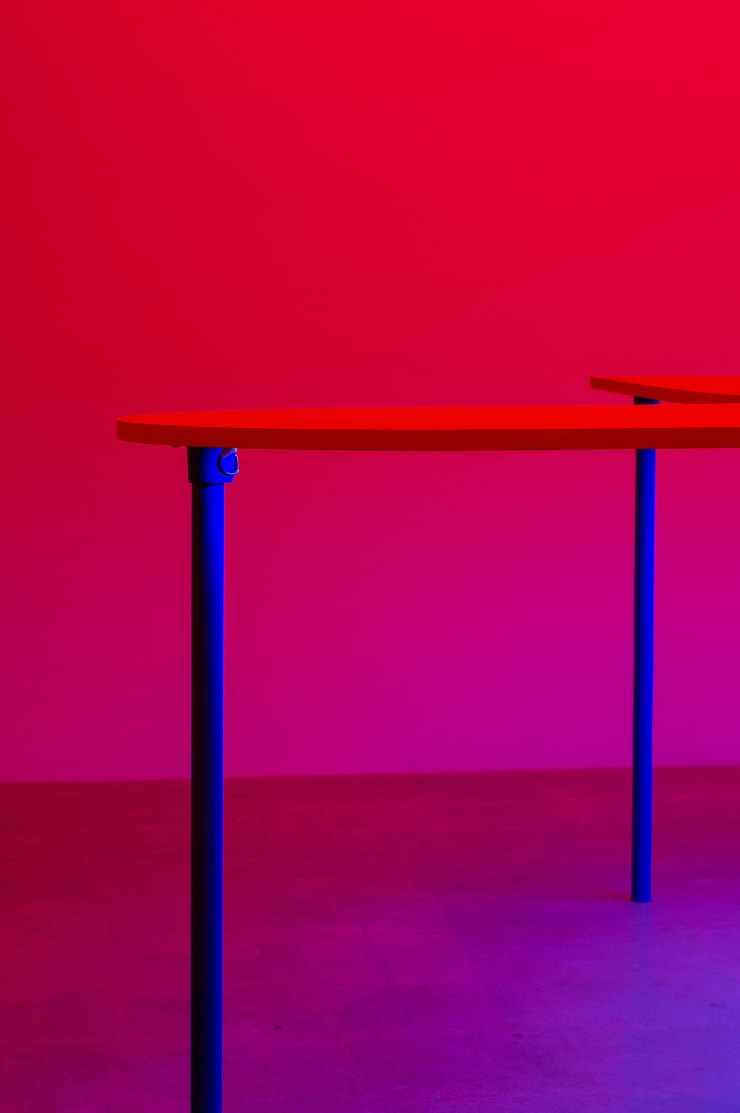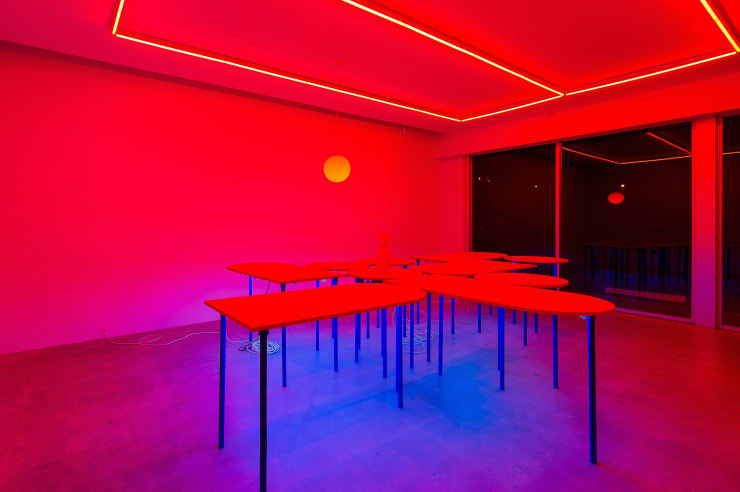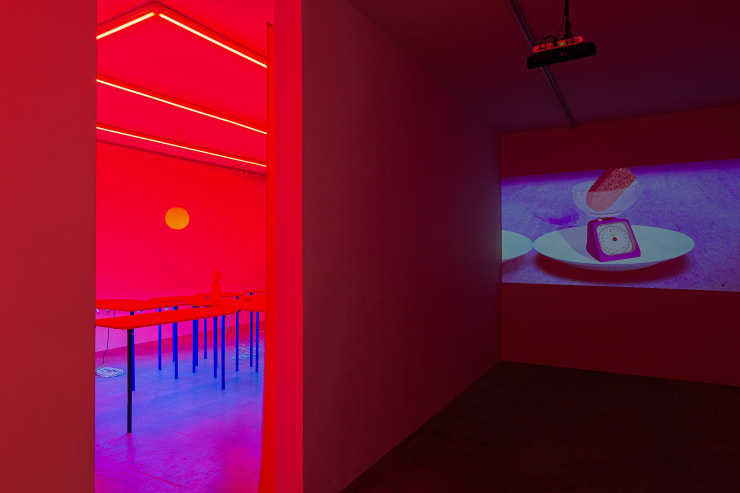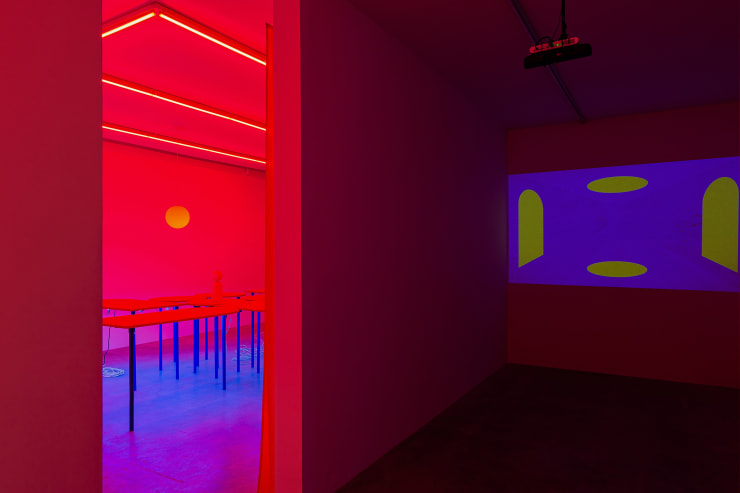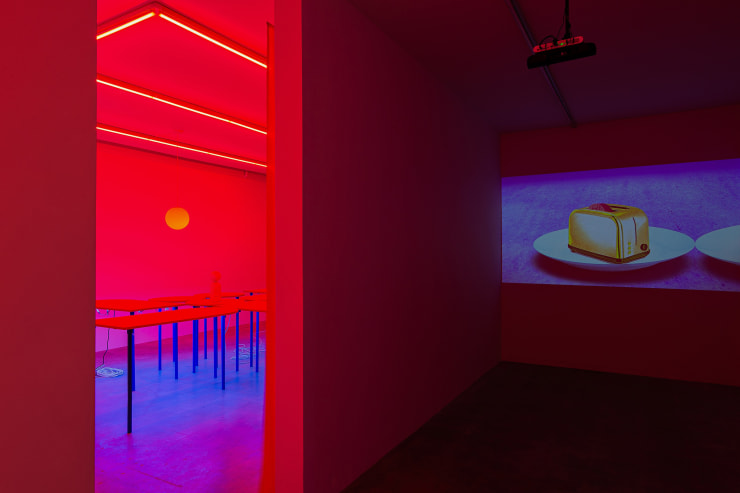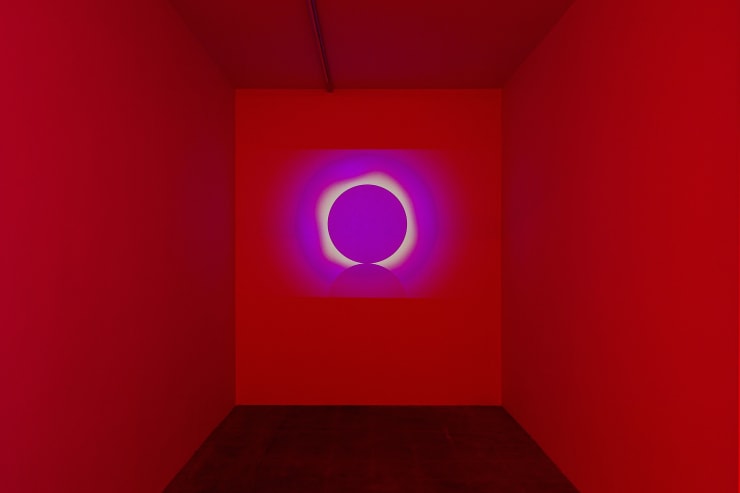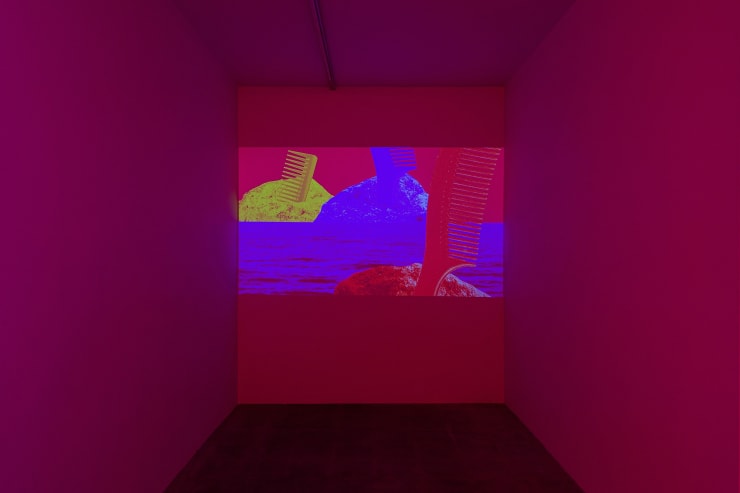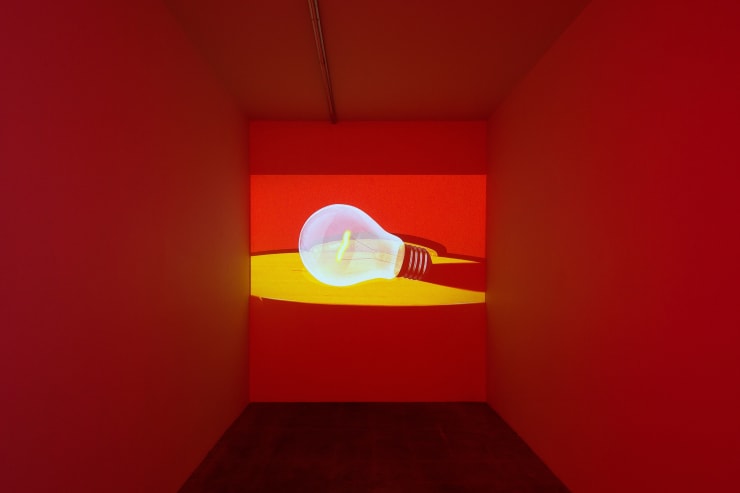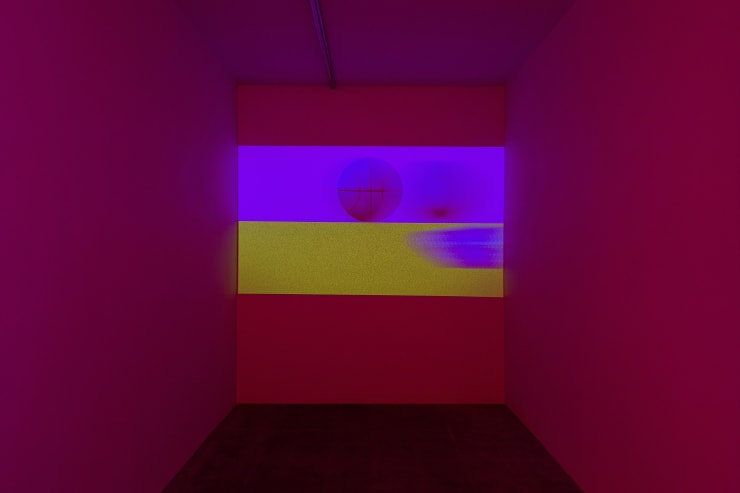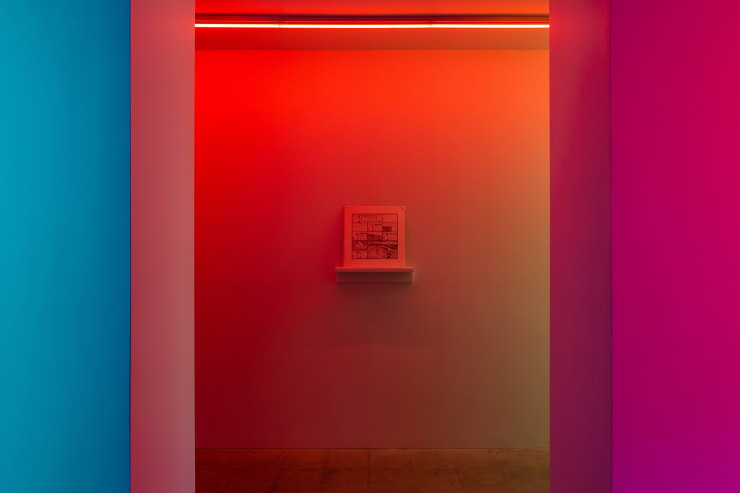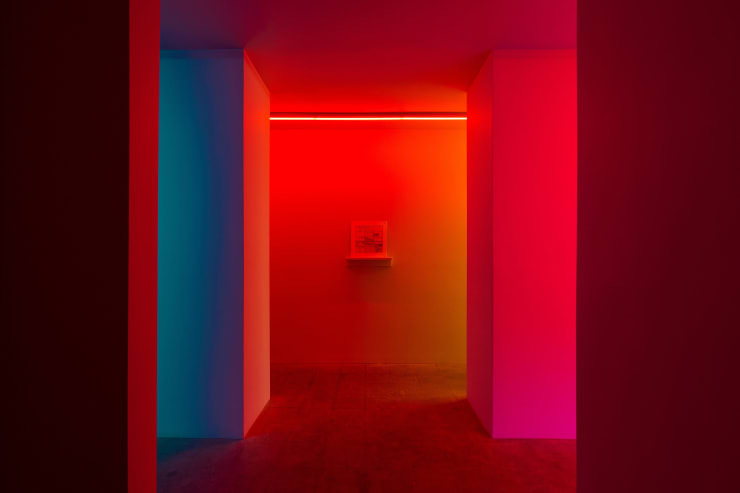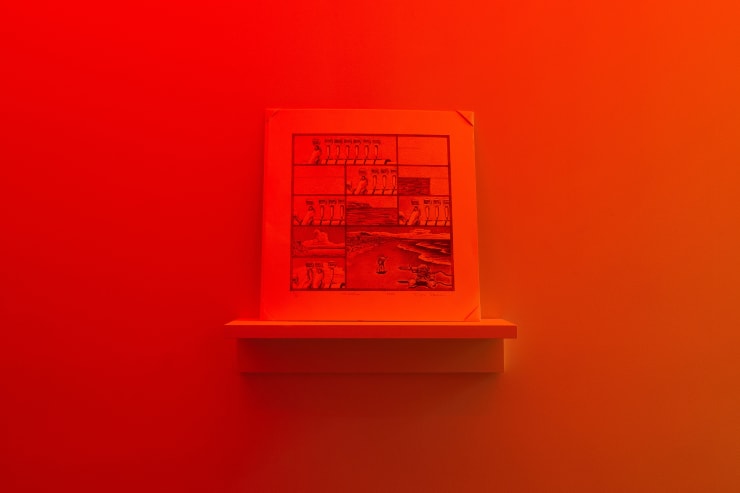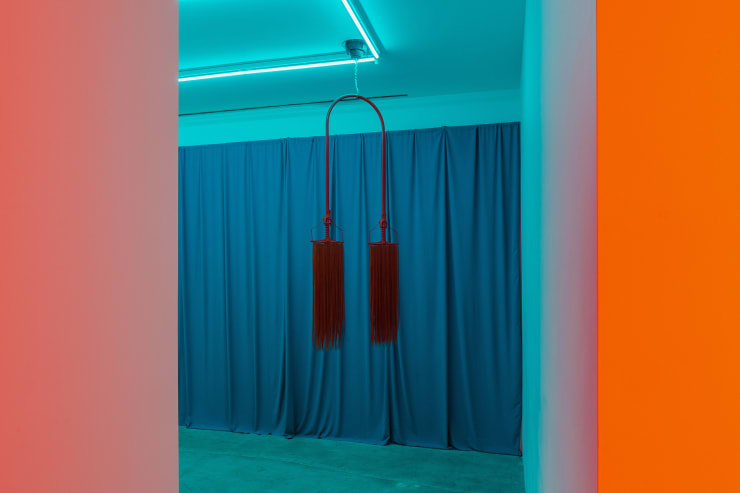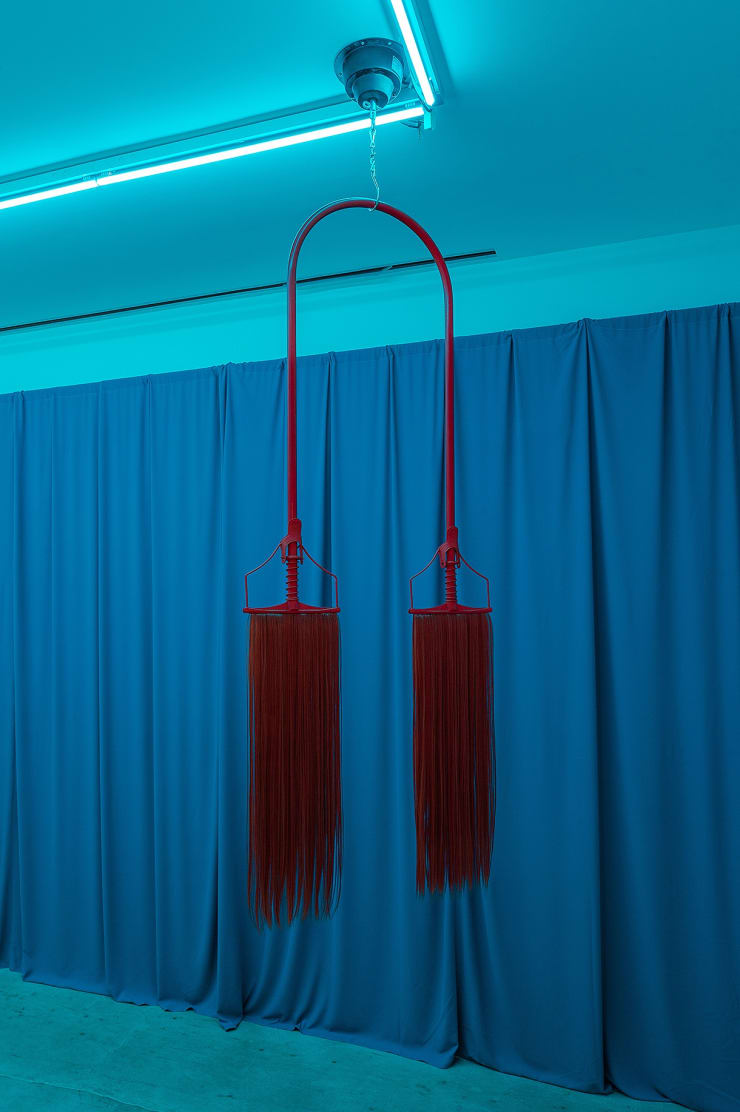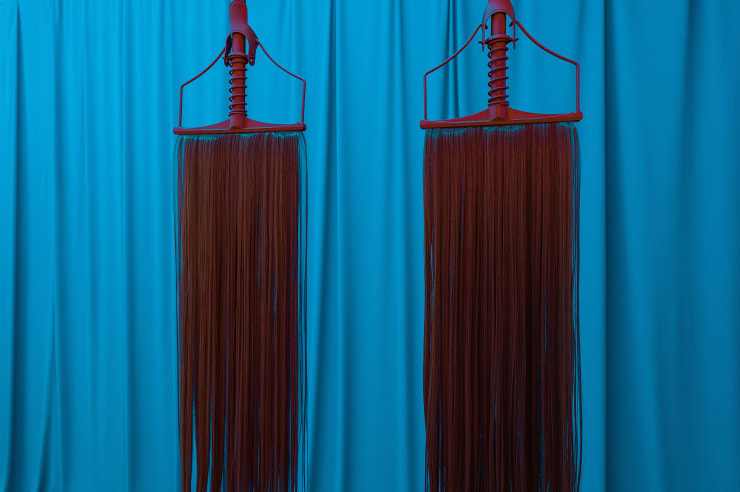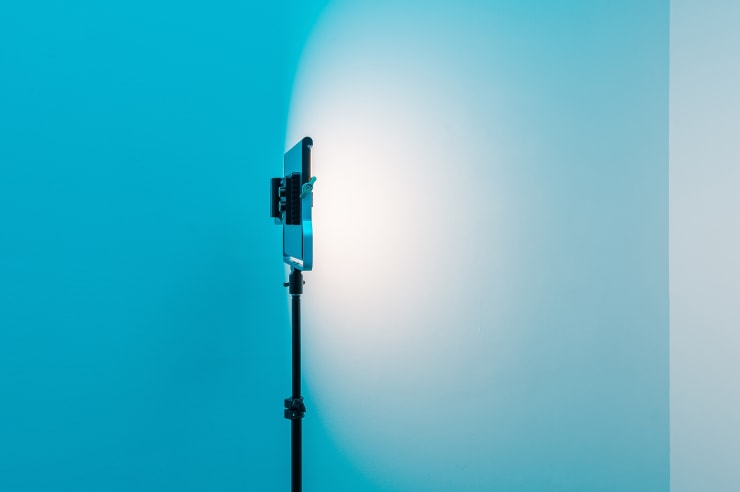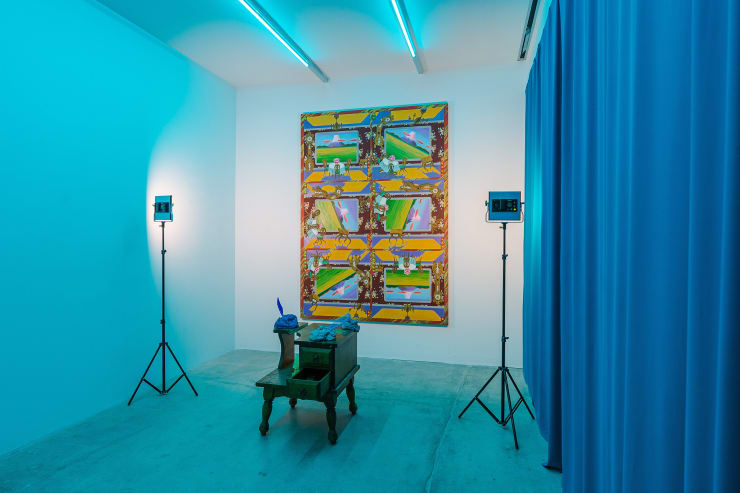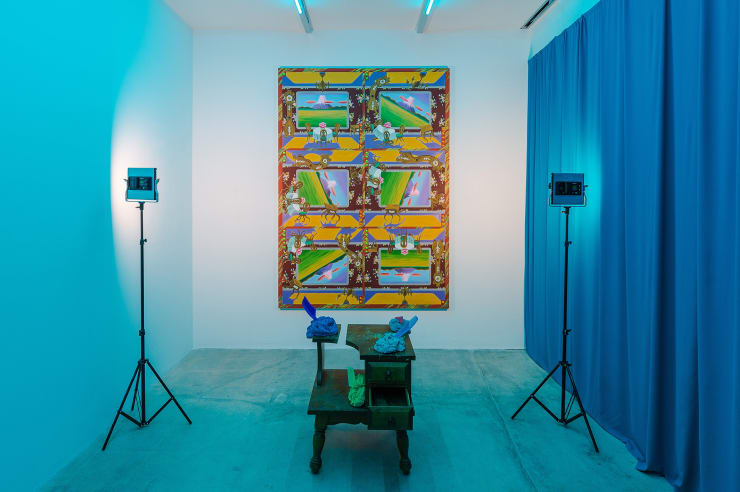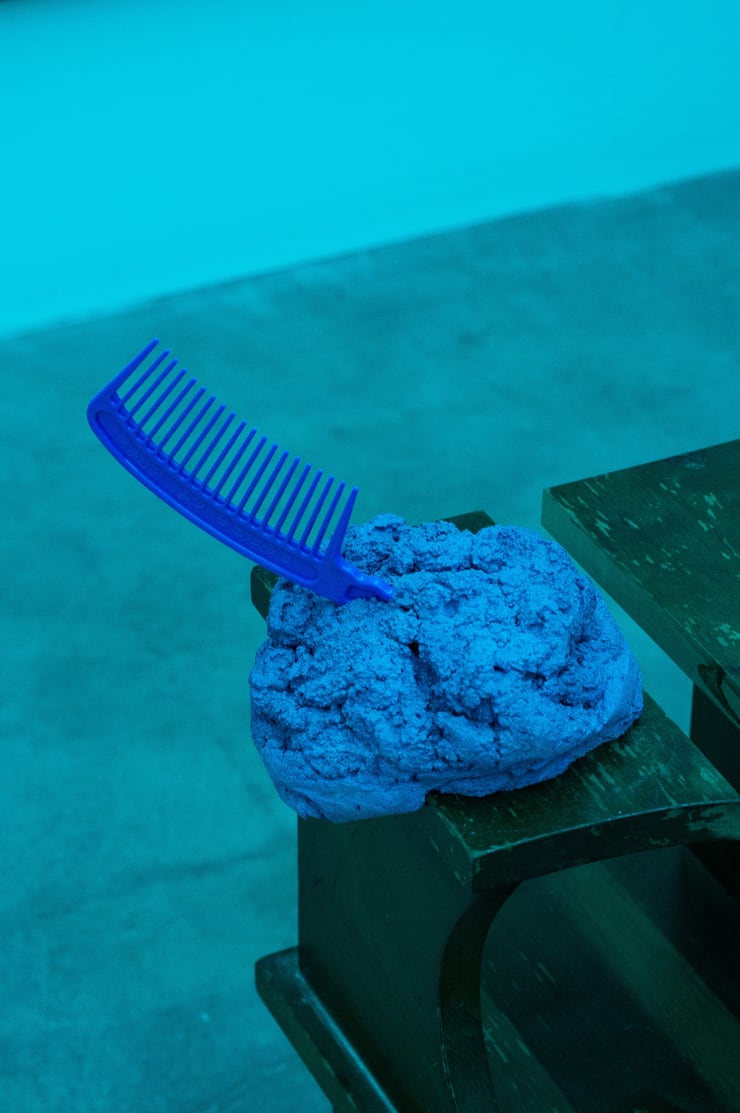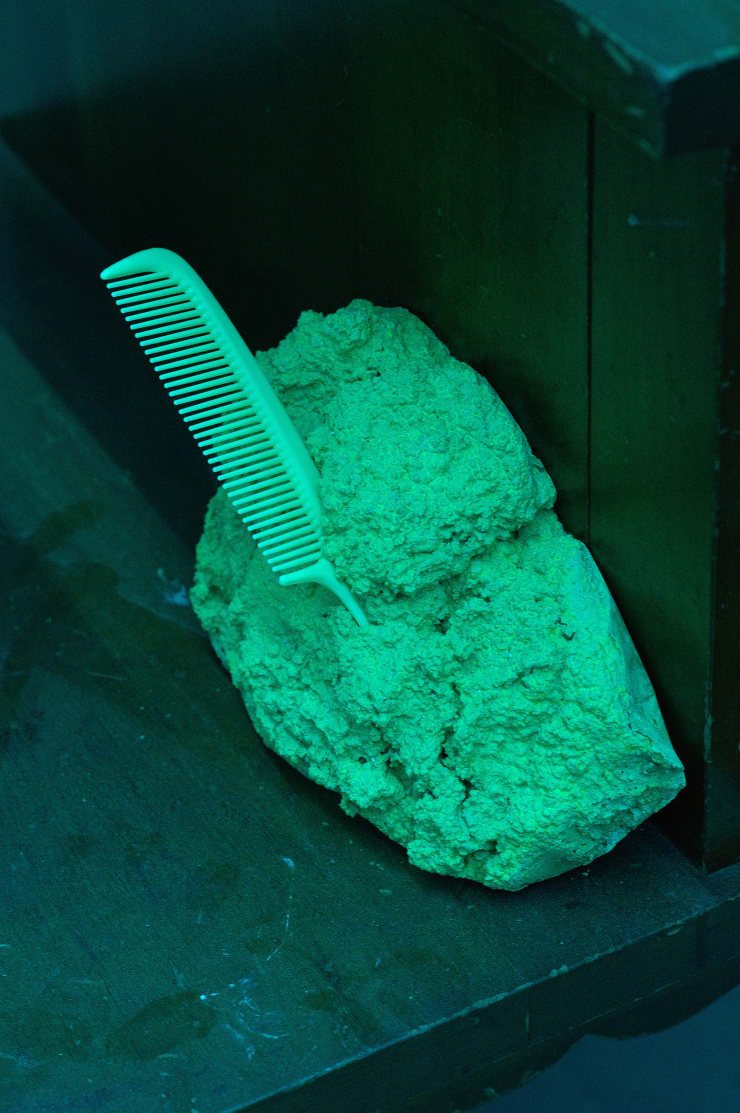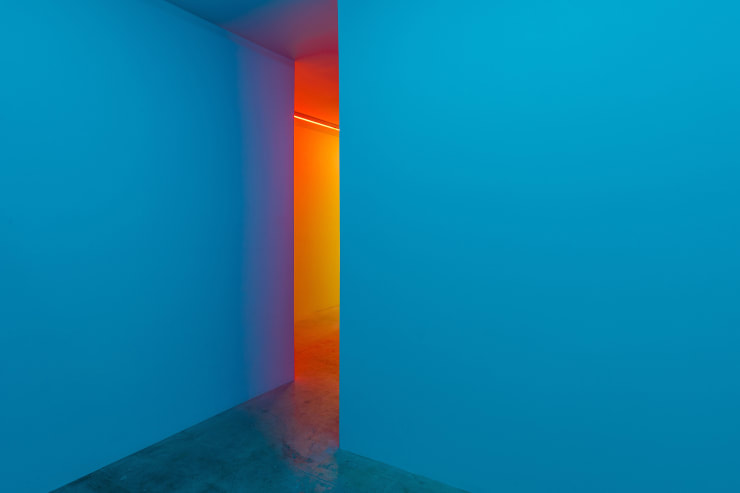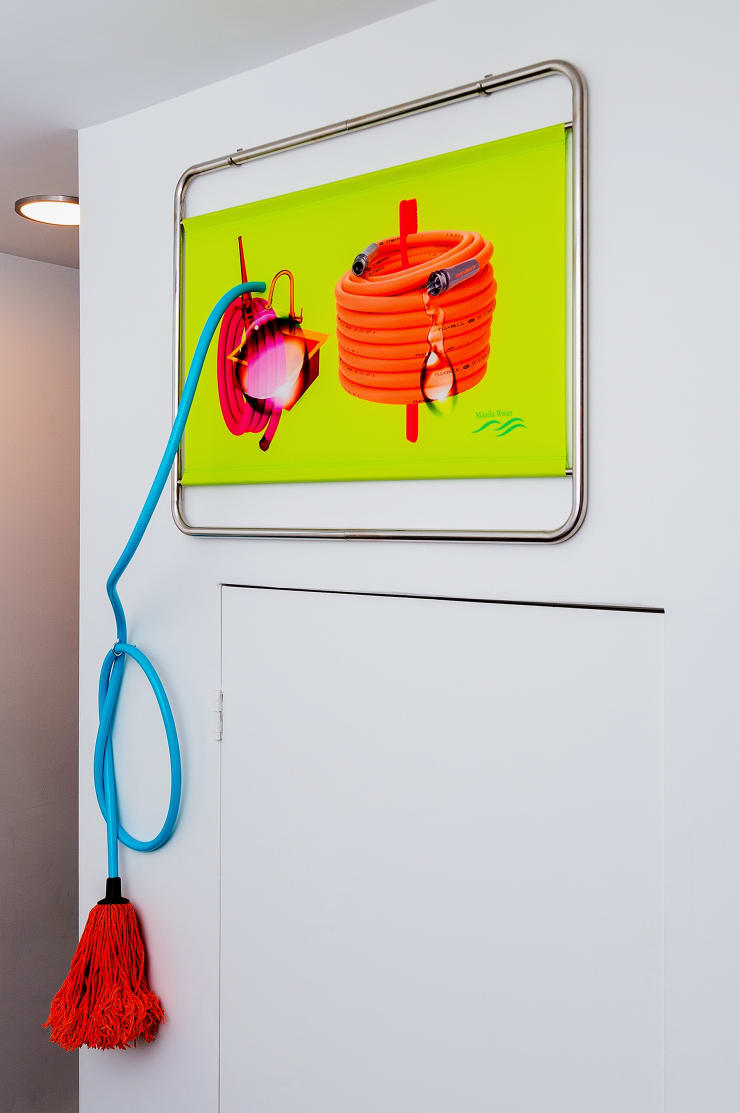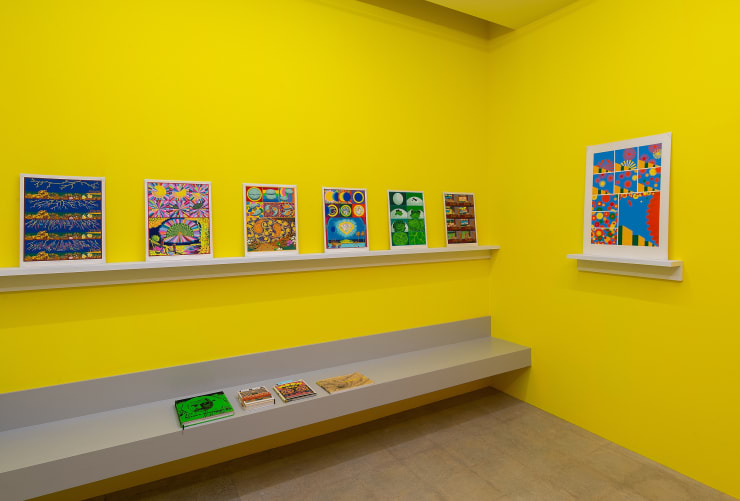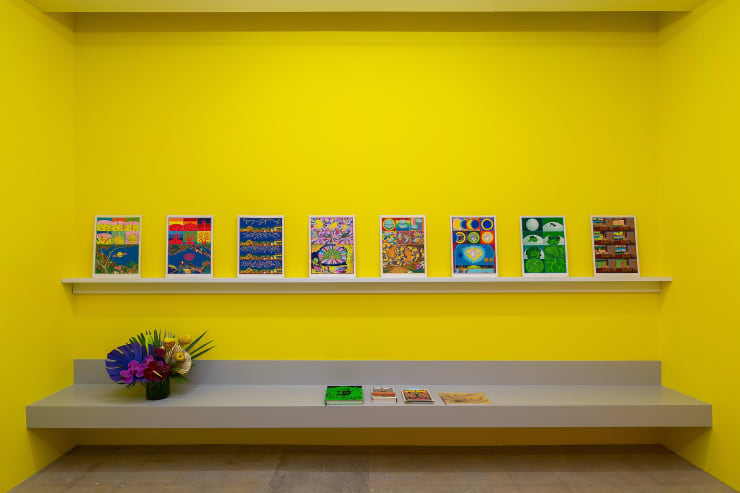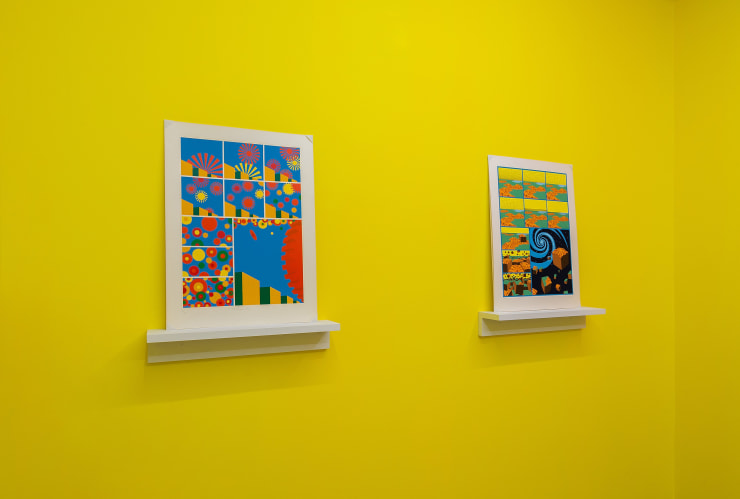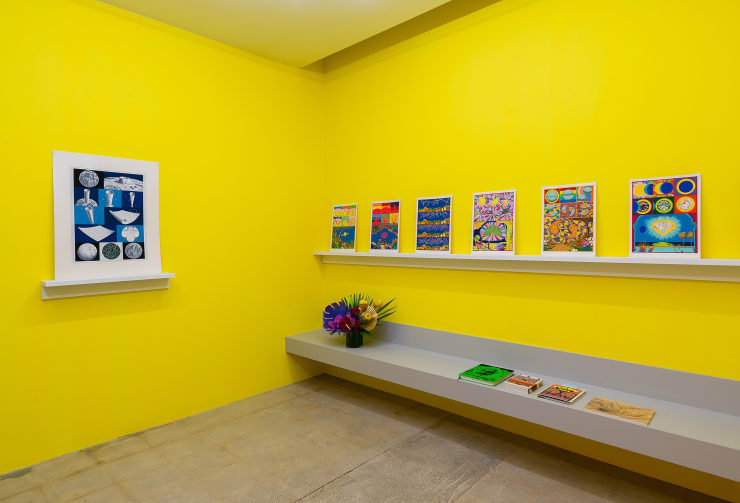Takuro Tamayama & Tiger Tateishi
Press:
ARTFORUM, November 19, 2019
Art Viewer, August 21, 2019
AUTRE, August 1, 2019
ArtsuZe, July 31, 2019
Nonaka-Hill is pleased to present a two-artist exhibition, Takuro Tamayama and Tiger Tateishi. The show features a new installation, video and sculpture works by Takuro Tamayama, brought together with Tiger Tateishi’s large oil painting Rotating Fuji from 1991 and selected prints dating from 1973-1981.
Takuro Tamayama and Tiger Tateishi, while generations apart, share penchants for surprising fantasy narrative works depicting evolutions of our planet and others, often through the anthropomorphism of common objects. While both artists engage a repertory of domestic symbols, always colorful and often spinning, Tamayama’s work appears distinctively spare and Tateishi’s work is distinctively baroque.
At the gallery entrance, Takuro Tamayama’s new monochrome yellow video Dance plays on a monitor, bathed in blue light from the underside of a semi-circular table. On the tabletop, a sculpture of a sandwich linked to a hamburger stands upright on a plate, looking “human”. The one-minute video shows a choreography of six rotating gold rocks, swirling into a configuration resembling one body as we know it (head/torso/ two arms/ two legs), then repositioning in three pairs, suggesting three even-more rudimentary bodies (head/body), all nodding, before all exit stage left/right. Adjacent, Tiger Tateishi’s Planets Blossom silkscreen presents a narrative image sequence of round planets cracking, transforming into rose planets. A red curtain leads to Tamayama’s colored light-saturated room scale immersive experience entitled Eclipse Dance (2019). A cluster of tables forms a new Pangea-like plateau, dividing the atmosphere’s light into intense red above and hazy blue below. A rotating veined white marble form, again evocative of a human, is positioned with tense relationship to a spherical form, evocative of a celestial body – perhaps a sun, or a moon. In the next space, Tamayama’s Eclipse, a new large-scale video projection with sound composed by the artist, presents well-known objects of domesticity (especially cleaning), cast into a weightless and elastic, unknown space. This atmosphere is also a narrative which shifts to reveal the silhouette of Tamayama’s rudimentary figure slowly eclipsing a hazy planet, all set to a repeating, trance-inducing stanza. A fourth space, saturated with blue light, presents Tamayama’s spinning red monochrome sculpture of a hanging, double-headed mop whose fiber string head has fully transitioned into long red, human hair. This rotating work confronts Tateishi’s comic-strip format painting Rotating Fuji (1991), which is lit precariously by white light imposed into the blue atmosphere. The painting depicts six views of Mt. Fuji tumbling outside the window of room, occupied by scampering furniture, all set within grids of floral wallpaper and marble. A fifth room, painted yellow, displays Tateishi’s prints dating from 1973 to 1981. Each of these works show a fantasy of planet formation, evolution and/or anthropomorphic transformation.
Takuro Tamayama: Attracted to the narratives which common objects can create in relationship with each other, Tamayama began staging objects and sculpture in room scaled installations as early as 2012. These immersive environments offer no linear means to comprehend Tamayama’s narrative, rather the environment is the decentralized narrative of symbols. Often, tools of the mundane rituals of cleaning and grooming abandoned of its designated role anthropomorphize into alien objects. In absence of human presence, the mop, an abstracted marble figure, hybrid hamburger and sandwich statue, and combs imbedded in irregular concrete forms, all having some human resonance, occupy the human void. In his recent works, Tamayama has utilized curtains to reorganize the space experience, and colored lights to saturate and destabilize the visual senses. He produces long-form video and music, adding to the time and non-materiel dynamics of these constructed spaces. Tamayama’s new video installation, Eclipse is inspired by Tateishi’s fascination with aliens, UFOs and outer space, as both artists construct alternate dimensions of illusions and fantasy.
Takuro Tamayama was born in 1990, Gifu Prefecture, Japan. He lives and works in Tokyo. Tamayama was awarded first place in Aichi University of the Arts, 2012 Class Bachelors of Fine Art Graduate Project, 2013. Tamayama received a Masters Degree in Fine Arts from the Tokyo University of the Arts in 2015. He is the recipient of Art Award Tokyo Marunouchi 2015 Shigeo Goto Award. Tamayama’s developing oeuvre includes installations, video, music, wall-based and sculptural works, as well as collaborative installation projects for Nike and the fashion brand, Zucca. He has had numerous solo and group exhibitions in Japan including recent solo shows, Dirty Palace at Calm & Punk Gallery, 2018 and They Hardly Ever Stand Still at Talion Gallery, 2019, both in Tokyo. This is Tamayama’s first exhibition outside of Japan.
Tiger Tateishi: Enchanted by Disney cartoons and American movies in his youth, Tiger Tateishi was later drawn to Mad Magazine and stories by science fiction authors, Ray Bradbury, Arthur C. Clarke, and Robert Sheckley. He began his art career in 1963, producing “Pop Art” paintings from a Japanese point of view, colliding Japan’s iconic Mt. Fuji, Godzilla, and Samurai together with international icons such as Mao Tse Tung, an atomic mushroom cloud, MAD Magazine’s Alfred E. Neuman, Coca-Cola, the American Western landscape and KKK processions. To parody the tourism initiatives of the 1964 Tokyo Olympic Games, Tateishi founded The Institute of Tourist Art (1964-66), creating works which operated off the Mt. Fuji as beloved national symbol and tourism moneymaker. His first solo exhibition of the same year was titled Accumulated Civilization, an idea which echoes through his oeuvre.
With the desire to draw “nonsense cartoons”, then unpopular in Japan, Tateishi and his wife Fumiko left for Milan in 1969, drawn to the city of Futurism. Notably, their move was concurrent with other new frontiers felt globally; Stanley Kubrick’s 2001: A Space Odyssey (1968) and the Apollo 11 first moon landing. As a consummate absorber of his surroundings, Tateishi met Giorgio de Chirico (whose perspectival style he had appropriated earlier in 1964) and merged de Chirico-style images into a new storyboard sequencing in his paintings. This format, usually only seen in comics, proved ideal for making paintings of Sci-Fi narratives. An employee of Ettore Sottsass’s saw these works and introduced the architect/designer to Tateishi and an extraordinary group of drawings were produced setting Sottsass’s early proposals for fantastical and erotic architectural forms in outer space terrains. While attributed to Sottsass, these works are often signed “Tiger pinxit”, Latin for “Tiger painted it”. Tateishi also started making silkscreen prints from the early 1970s in Milan, a selection of which are on view. These works, and Rotating Fuji incorporate the story-board format which Tateishi continued to utilize in paintings, drawings and artist’s books throughout his career.
Tiger (Kōichi) Tateishi was born in 1941, Fukuoka Prefecture, Japan. He passed away in 1998. He received a degree from Musashino University Junior College of Art and Design in 1963. Tateishi’s vast oeuvre includes oil painting, prints, comics, illustration, children’s books, and ceramics. Since 1963, the artist has had numerous solo and group exhibitions in Japan, Europe, and the United States. After his death, two retrospectives were organized: Tiger Tateishi: The Endless Tiger at Tagawa City Art Museum, 1999 and Metamorphose Tiger: Walking through the Labyrinth with Tiger Tateishi, O Museum,1999 (cat.). Tateishi was featured in a two-artist shows, The World is Strange! The Manga and painting of Tiger Tateishi and Yuichi Yokoyama, Hiroshima City Museum of Contemporary Art, 2017. Recent group exhibitions include Tokyo 1955-1970: A New Avant Garde, 2012; The Museum of Modern Art, New York, Japanorama: A New Vision on Art Since 1970,Centre Pompidou-Metz, 2018. A touring Tateishi survey exhibition is planned for 2020/2021 appearing at Chiba City Museum of Art, Aomori Museum of Art, Takamatasu Art Museum and The Museum of Modern Art, Saitama.
 Takuro TamayamaInstallation (Eclipse Dance), 2019Marble, globe lamp, colored fluorescent lights, LED lights, MDF boards, aluminum pipes, motorInstallation variable.
Takuro TamayamaInstallation (Eclipse Dance), 2019Marble, globe lamp, colored fluorescent lights, LED lights, MDF boards, aluminum pipes, motorInstallation variable.
Marble: 370 x 130 x 130 mm
14-5/8 x 5-1/4 x 5-1/4 inch
Table Small: 850 x 700 x 700 mm
33-1/2 x 27-9/16 x 27-9/16 inch
Table Large: 850 x 700 x 1400 mm
33-1/2 x 27-9/16 x 55-1/8 inch Takuro TamayamaBurger and Sandwich, 2019Resin, sesame, plate.26.5 x 24 x 24 cm
Takuro TamayamaBurger and Sandwich, 2019Resin, sesame, plate.26.5 x 24 x 24 cm
10-1/2 x 9-1/2 x 9-1/2 inch Takuro TamayamaSpinning Mop (Red hair), 2019Stainless steel, wigs, motor and etc.1700 x 650 x 30 mm
Takuro TamayamaSpinning Mop (Red hair), 2019Stainless steel, wigs, motor and etc.1700 x 650 x 30 mm
66-15/16 x 25-5/8 x 1-3/16 inch Takuro TamayamaComb and Side Table, 2019Comb, concrete, wood side table845 x 685 x 787 mm
Takuro TamayamaComb and Side Table, 2019Comb, concrete, wood side table845 x 685 x 787 mm
33-5/16 x 26-15/16 x 31 inch Takuro TamayamaDance, 2019Digital video, 1 min. loop
Takuro TamayamaDance, 2019Digital video, 1 min. loop Takuro TamayamaEclipse, 2019Digital video, 19 min. loop
Takuro TamayamaEclipse, 2019Digital video, 19 min. loop Takuro TamayamaWatering, 2019Print on polyester, stainless steel, hose and mop730 - 1750mm (adjustable hose) x 910 x 200 mm
Takuro TamayamaWatering, 2019Print on polyester, stainless steel, hose and mop730 - 1750mm (adjustable hose) x 910 x 200 mm
28-3/4 - 68-15/16 x 35-7/8 x 7-7/8 inch Tiger TateishiRevolving Fuji (回転富士), 1991Oil on canvas.89-1/2 x 63 inches
Tiger TateishiRevolving Fuji (回転富士), 1991Oil on canvas.89-1/2 x 63 inches
227.3 x 160 cm Tiger TateishiPlanets Blossom, 1973Silk screen on paperimage size H24-13/16 x W18-1/2 inches, sheet size H29-3/4 x W22-1/2 inches,
Tiger TateishiPlanets Blossom, 1973Silk screen on paperimage size H24-13/16 x W18-1/2 inches, sheet size H29-3/4 x W22-1/2 inches,
image size H63 x W47 cm, sheet size H75.5 x W57 cm Tiger TateishiMoon's Satisfaction, 1979Silk screen on paperimage size 16-9/16 x 12-7/16 inches
Tiger TateishiMoon's Satisfaction, 1979Silk screen on paperimage size 16-9/16 x 12-7/16 inches
sheet size 18-1/8 x 13-7/16 inches
image size 42 x 31.5 cm
sheet size 46 x 34 cm Tiger TateishiPeacock Moon, 1979Silk screen on paperimage size H16-9/16 x W12-7/16 inches, sheet size H18-1/8 x W13-7/16 inches,
Tiger TateishiPeacock Moon, 1979Silk screen on paperimage size H16-9/16 x W12-7/16 inches, sheet size H18-1/8 x W13-7/16 inches,
image size H42 x W31.5 cm, sheet size H46 x W34 cm Tiger TateishiPisa, 1979Silk screen on paperimage size 16-9/16 x 12-7/16 inches
Tiger TateishiPisa, 1979Silk screen on paperimage size 16-9/16 x 12-7/16 inches
sheet size 18-1/8 x 13-7/16 inches
image size 42 x 31.5 cm
sheet size 46 x 34 cm Tiger TateishiThe First Suggestion, 1979Silk screen on paperimage size H16-9/16 x W12-7/16 inches, sheet size H18-1/8 x W13-7/16 inches,
Tiger TateishiThe First Suggestion, 1979Silk screen on paperimage size H16-9/16 x W12-7/16 inches, sheet size H18-1/8 x W13-7/16 inches,
image size H42 x W31.5 cm, sheet size H46 x W34 cm Tiger TateishiTime Elevator, 1979Silk screen on paperimage size 16-9/16 x 12-7/16 inches
Tiger TateishiTime Elevator, 1979Silk screen on paperimage size 16-9/16 x 12-7/16 inches
sheet size 18-1/8 x 13-7/16 inches
image size 42 x 31.5 cm
sheet size 46 x 34 cm Tiger TateishiBeautiful Moon, 1979Silk screen on paperimage: H16-9/16 x W12-7/16 inches
Tiger TateishiBeautiful Moon, 1979Silk screen on paperimage: H16-9/16 x W12-7/16 inches
sheet: H18-1/8 x W13-7/16 inches
image: H42 x W31.5 cm
sheet: H46 x W34 cm Tiger TateishiBig Diamond, 1979Silk screen on paperimage size 16-9/16 x 12-7/16 inches
Tiger TateishiBig Diamond, 1979Silk screen on paperimage size 16-9/16 x 12-7/16 inches
sheet size 18-1/8 x 13-7/16 inches
image size 42 x 31.5 cm
sheet size H46 x W34 cm Tiger TateishiCabbage Moon, 1979Silk screen on paperimage size 16-9/16 x 12-7/16 inches
Tiger TateishiCabbage Moon, 1979Silk screen on paperimage size 16-9/16 x 12-7/16 inches
sheet size 18-1/8 x 13-7/16 inches
image size 42 x 31.5 cm
sheet size 46 x 34 cm Tiger TateishiCoral Moon, 1978Silk screen on paperimage size 16-9/16 x 12-7/16 inches
Tiger TateishiCoral Moon, 1978Silk screen on paperimage size 16-9/16 x 12-7/16 inches
sheet size 18-1/8 x 13-7/16 inches
image size 42 x 31.5 cm
sheet size 46 x 34 cm Tiger TateishiThe Organic Whole, 1974Silk screen on paperimage size 26-7/16 x 19-5/16 inches
Tiger TateishiThe Organic Whole, 1974Silk screen on paperimage size 26-7/16 x 19-5/16 inches
sheet size 29-15/16 x 22-1/2 inches
image size H67 x W49 cm
sheet size H76 x W57 cm Tiger TateishiCubic Worlds, 1973Silk screen on paperimage size 26-7/16 x 19-5/16 inches
Tiger TateishiCubic Worlds, 1973Silk screen on paperimage size 26-7/16 x 19-5/16 inches
sheet size 29-15/16 x 22-1/2 inches
image size 67 x 49 cm
sheet size 76 x 57 cm Tiger TateishiMoon Grows to the Moon, 1981Silk screen on paperimage size 25-1/4 x 18-1/2 inches
Tiger TateishiMoon Grows to the Moon, 1981Silk screen on paperimage size 25-1/4 x 18-1/2 inches
sheet size 32-11/16 x 25-5/8 inches
image size 64 x 47 cm
sheet size 83 x 65 cm Tiger TateishiThe Machine, 1978Lithographsheet size 18-1/2 x 18-1/8 inches
Tiger TateishiThe Machine, 1978Lithographsheet size 18-1/2 x 18-1/8 inches
sheet size 47 x 46 cm
-

Installation View:
Takuro Tamayama and Tiger Tateishi.
Silk Screen on Paper by Tiger Tateishi
-

-

-

-

-

-

-

-

-

-

-

-

-

-

-

-

-

-

-

-

-

-

-

-

-

-

-

-

Lithograph by Tiger Tateishi
-

Lithograph by Tiger Tateishi
-

Lithograph by Tiger Tateishi
-

-

Painting by Tiger Tateishi
-

-

-

-

-

-

-

-

-

-

-

-

-

-

-

-

-

-

-

-

-

Installation View: Tiger Tateishi
-

Installation View: Tiger Tateishi
-

Installation View: Tiger Tateishi
-

Installation View: Tiger Tateishi
-

Installation View: Tiger Tateishi
-

Installation View: Tiger Tateishi
-

Installation View:
Takuro Tamayama and Tiger Tateishi.
Silk Screen on Paper by Tiger Tateishi
Related Artists
Artist Exhibited:
Ulala Imai
Kazuo Kadonaga
Kentaro Kawabata
Zenzaburo Kojima
Kisho Kurokawa
Tadaaki Kuwayama
Toshio Matsumoto
Keita Matsunaga
Yutaka Matsuzawa
Kimiyo Mishima
Kunié Sugiura
Takuro Tamayama
Tiger Tateishi
Sofu Teshigahara
Shomei Tomatsu
Wataru Tominaga
Hosai Matsubayashi XVI
Kansuke Yamamoto
Masaomi Yasunaga
Exhibitions:
-2025-
KEY HIRAGA: The Elegant Life of Mr. H
-2024-
KYOKO IDETSU: What can an ideology do for me?
KENTARO KAWABATA / BRUCE NAUMAN
SAORI (MADOKORO) AKUTAGAWA: CENTENARIA
Keita Matsunaga : Accumulation Flow
-2023-
NONAKA-HILL ♥ TATAMI ANTIQUES: A holiday sale of unique objects from Japan
TAKASHI HOMMA : REVOLUTION No.9 / Camera Obscura Studies
TATSUMI HIJIKATA THE LAST BUTOH: Photographs by Yasuo Kuroda
Kiyomizu Rokubey VIII: CERAMIC SIGHT
Masaomi Yasunaga: 石拾いからの発見 / discoveries from picking up stones
SHUZO AZUCHI GULLIVER ‘Synogenesis’
Koichi Enomoto: Against the day
Tatsuo Ikeda / Michael E. Smith
Hiroshi Sugito: the garden with Zenzaburo Kojima
Zenzaburo Kojima: This very green
Tomohisa Obana: To see the rainbow at night, I must make it myself
Daisuke Fukunaga: Beautiful Work
- 2021 -
Natsuyasumi: In the Beginning Was Love
Takashi Homma: mushrooms from the forest
– 2020 –
Hosai Matsubayashi XVI & Trevor Shimizu
Sterling Ruby and Masaomi Yasunaga
– 2019 –
A show about an architectural monograph
Yutaka Matsuzawa
Yutaka Matsuzawa through the lens of Mitsutoshi Hanaga
Takuro Tamayama & Tiger Tateishi
Kunié Sugiura
Masaomi Yasunaga
Miho Dohi
Wataru Tominaga
Naotaka Hiro
Parergon: Japanese Art of the 1980s and 1990s
Tadaaki Kuwayama
– 2018 –
Toshio Matsumoto
Kentaro Kawabata
Kansuke Yamamoto
Kazuo Kadonaga: Wood / Paper / Bamboo / Glass
Press:
-2025-
Artillery Magazine, Sawako Goda
-2024-
Artsy, Nonaka-Hill
Richesse, Nonaka-Hill Kyoto
Bijutsutecho, Nonaka-Hill Kyoto
The Art Newspaper, Nonaka-Hill Kyoto
Meer, Kyoko Idetsu
Bijyutsutecho, Masaomi Yasunaga
Switch, Masaomi Yasunaga
ARTnews JAPAN, Masaomi Yasunaga
Richesse, Masaomi Yasunaga
Art Basel, Daisuke Fukunaga, Imai Ulala
Art Basel, Kazuo Kadonaga, Sofu Teshigahara
-2023-
ADF webmagazine, Yasuo Kuroda, Tatsumi Hijikata
e-flux, Sanya Kantarofsky, Yasuo Kuroda
Los Angeles Times, Kenzi Shiokava
Artillery, Masaomi Yasunaga
Contemporary Art Daily Shuzo Azuchi Gulliver
- 2022 -
Contemporary Art Daily, Tomohisa Obana
ARTE FUSE, Daisuke Fukunaga
Contemporary Art Daily, Daisuke Fukunaga
Contemporary Art Review Los Angeles (Carla), Daisuke Fukunaga
What's on Los Angeles, Daisuke Fukunaga
Hyperallergic, Daisuke Fukunaga
Artillery, Kentaro Kawabata
Larchmont Buzz, entaro Kawabata
- 2021 -
Art Viewer, Natsuyasumi: In the Beginning Was Love
Hyperallergic, Natsuyasumi: In the Beginning Was Love
Art Viewer, Takashi Homma
Hyperallergic, Busy Work at Home
Art Viewer, Busy Work at Home
Hyperallergic, Ulala Imai
Contemporary Art Review Los Angeles (Carla), Ulala Imai
Contemporary Art Daily, Ulala Imai
artillery, Ulala Imai
Special Ops, Ulala Imai
Art Viewer, Ulala Imai
artillery, Matsubayashi & Trevor Shimizu
– 2020 –
Ceramic Now, Sterling Ryby and Masaomi Yasunaga
Hypebeast, Sterling Ryby and Masaomi Yasunaga
Art Viewer, Sterling Ruby and Masaomi Yasunaga
Air Mail, Sterling Ruby and Masaomi Yasunaga
Los Angeles Times, Kaz Oshiro
ArtnowLA, Kaz Oshiro
What's on Los Angeles, Kaz Oshiro
KCRW, Kaz Oshiro
Tique, Kaz Oshiro
Contemporary Art Daily, Kaz Oshiro
Art Viewer, Kaz Oshiro
Contemporary Art Daily, Sofu Teshigahara
Art Viewer, Sofu Teshigahara
KCRW, Sofu Tsshigahara
Hyperallergic, Nonaka-Hill
Los Angeles Times, Keita Matsunaga
– 2019 –
Los Angeles Times, Tatsumi Hijikata
Art Viewer, Tatsumi Hijikata, Eikoh Hosoe
Contemporary Art Review Los Angeles, Tatsumi Hijikata, Eikoh Hosoe
ArtAsiaPacific, Yutaka Matsuzawa
Los Angeles Times, Tatsumi Hijikata
AUTRE, Tatsumi Hijikata, Eikoh Hosoe
Los Angeles Times, Nonaka-Hill
ARTFORUM, Takuro Tamayama, Tiger Tateishi
Art Viewer, Takuro Tamayama, Tiger Tateishi
KCRW, Nonaka-Hill
LA WEEKLY, Nonaka-Hill
AUTRE, Takuro Tamayama, Tiger Tateishi
ArtsuZe, Takuro Tamayama, Tiger Tateishi
ARTFORUM, Review: Tadaaki Kuwayama, Rakuko Naito
Art Viewer, Masaomi Yasunaga, Kunié Sugiura
Los Angeles Times, Masaomi Yasunaga
KQED, Tadaaki Kuwayama, Rakuko Naito
Contemporary Art Daily, Naotaka Hiro, Wataru Tominaga, Miho Dohi
Los Angeles Times, Miho Dohi
Los Angeles Review of Books, Miho Dohi
Bijutsu Techo, Naotaka Hiro, Wataru Tominaga, Miho Dohi
Art Viewer, Miho Dohi
Art & Object, Parergon
COOL HUNTING, Felix Art Fair
Art Viewer, Tadaaki Kuwayama
artnet news, Nonaka-Hill
Contemporary Art Review Los Angeles (Carla), Tadaaki Kuwayama
– 2018 –
Art Viewer, Kentaro Kawabata
Contemporary Art Daily, Kazuo kadonaga
Los Angeles Times, Kazuo Kadonaga
ARTFORUM, Kazuo Kadonaga
Contemporary Art Daily, Shomei Tomatsu
KCRW, Kimiyo Mishima, Shomei Tomatsu
This website uses cookies
This site uses cookies to help make it more useful to you. Find out more about cookies.




